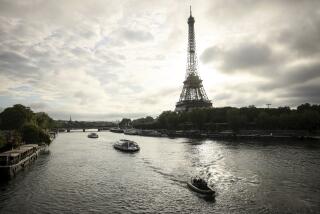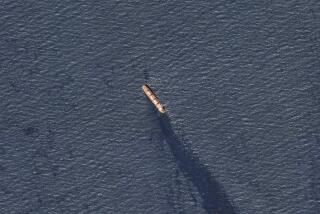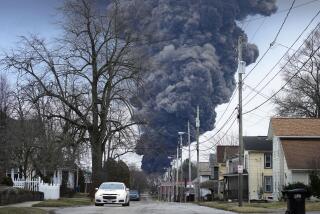These Days, Watch on the Rhine Reveals New Perils of Pollution
BRUSSELS â Quiet Swiss night, plashing waters from the Alps, susuration of leaves in the dark forest. Pan to careless flame creeping up warehouse wall; sirens and fire trucks, the arc of water from hoses. A purplish tide heavy with poison overflowing catch basins down to the historic river. Succeeding days marked along the shoals by Rhine eels dying, marked in various parliaments by angry speeches. Morose watermen and bargemen along the miles of misty banks staring out from under peaked caps and reflecting on their disappearing livelihood.
Someday perhaps it will make a film, but this month it has been too real for Europeans living with daily installments from television and newspapers. It was at first an obscure one-paragraph article about some trouble at a Sandoz AG chemicals warehouse on the Rhine near Basel--a chemical spill of between 10 and 30 metric tons of insecticides containing phosphorus compounds and fungicides containing mercury. Now the story has grown to become the center of government and public consciousness.
Switzerland, where the fire started, is not part of the 12-member European Economic Community, but the other countries that the Rhine touches--France, West Germany, the Netherlands--are; so the devastation has become one of many obstacles in the way of a continuing hope for a united Europe.
Whatever happened during the accident, later Swiss protestations of innocence became weaker every day. Switzerland, along with Sweden and Ireland, is among the professed neutrals of Europe in matters of defense. Switzerland, along with Luxembourg, Andorra and San Marino, is among the professed neutrals of Europe in matters of finance. What the country perhaps has learned since the Sandoz fire is that in environmental matters it is not possible to be neutral.
Neelie Smit-Kroes, the no-nonsense Dutch minister of transport and waterways, put the matter best at a hurriedly called conference of affected countries in Switzerland. âWe always considered the Swiss so clean,â she said. âThat is why we are now so disappointed.â
Like many countries, Switzerland has an elaborate code of standards for chemical production and storage. Chemicals are among the countryâs main exports, through Sandoz, Ciba-Geigy AG, Hoffman-Laroche and smaller concerns. Switzerland had some unwanted attention a decade ago when Hoffman-Larocheâs factory in Seveso, Italy, leaked poisonous gas; that accident provoked worldwide concern and a new European standard for chemical production. The announcement by Sandoz two weeks ago, that it was cutting back production of poisonous insecticides by 60% along the Rhine, made suspicious people wonder whether production would be shifted elsewhere--someplace like Seveso.
According to the investigations so far, the disaster in Basel was the result of accidents. First, the fire itself. Then the fact that a special fire brigade trained to deal with chemical blazes left duty at midnight; the Sandoz fire was fought by regular firemen. Finally, a disputed communications accident: The Swiss asserted that a âmisunderstandingâ caused a 24-hour delay before the countries downstream were warned of the devastating slick, more than 30 miles long, coming their way.
So the poison moved downstream, at first without notice. Fortunately, by the time it reached Holland, Smit-Kroes ordered the locks on canals closed so that the area of greatest danger moved out to the North Sea. Otherwise the Netherlands itself would have been faced with a decade of pollution on inland waters.
In the aftermath of the Sandoz spill came ample evidence that the state of the Rhine is perilous even without major accidents. Ciba-Geigy acknowledged the leak of highly toxic herbicides, 78 gallons of them, into the river the day before the Sandoz fire. On Nov. 21, the BASF Farben & Fasern AG chemical plant, near Ludwigshafen in West Germany, reported an accidental release of two tons of weed killer. On Nov. 24, an oil slick more than seven miles long, apparently spilled by a passing barge, suddenly neared Meinz.
Countries along the Rhine have been meeting for years to find a coordinated plan for cleaning up the river, with little to show for thousands of hours of talk and thousands of pages of proposals. The European Community, having spent six years working to adopt guidelines for the handling and storage of chemicals after the Seveso disaster, met last week and agreed to tighten some requirements.
But the 12 nations could not agree at all on a more far-reaching measure--control of air pollution from coal-fired power plants to curtail acid rain. As is usual in such discussions, the countries causing the most harm insisted they needed the most time to clean up their acts. Britain said it could cut dangerous emissions from power plants by 45% by the year 2005. This pace was rejected as laggard by West Germany, Denmark and the Netherlands, where the prevailing winds carry Britainâs acid rain.
Sandoz and Switzerland have agreed to pay compensation for the damage to the Rhine, but the amount to be paid is far from agreed. Political analysts say that the various Green movements, particularly the one in West Germany, will benefit from the protests raised by the accident. The West German Greens gained some seats in the recent local elections in Hamburg, apparently on the strength of Chernobyl, and could only hope to gain more after the national elections in January.
The biggest effect, however, is in pollution, not politics. Environmentalists estimate that it will take a least 10 years for the insecticides and mercury to be washed away, a whole decade before the tiny organisms that feed aquatic life can come back. Most dismaying of all is the reversal of a gradual cleanup on the Rhine that marked the 1970s and â80s. In 1980, for example, fisheries biologists painstakingly raised 30,000 young salmon and sent them out to sea. There is not much hope now that they will return.
More to Read
Sign up for Essential California
The most important California stories and recommendations in your inbox every morning.
You may occasionally receive promotional content from the Los Angeles Times.










